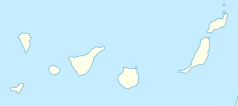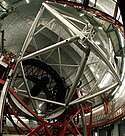Wielki Teleskop Kanaryjski
 Teleskop Gran Telescopio Canarias | |
| Państwo | |
|---|---|
| Organizacja | Instituto de Astrofísica de Canarias, |
| Lokalizacja | |
| Wysokość n.p.m. | 2267[1] |
| Zakres widma | optyczne, podczerwień |
| Rozpoczęcie budowy | 2002 |
| Ukończenie budowy | 2008 |
| Typ | |
| Średnica zwierciadła | 10,4 m |
| Powierzchnia zwierciadła | 74,1 m² |
| Długość ogniskowej | 16,5 m |
| Montaż | azymutalny |
| Kopuła | sferyczna |
| Strona internetowa | |
Wielki Teleskop Kanaryjski (Gran Telescopio Canarias, znany również pod nazwą GranTeCan i skrótem GTC) – wielki teleskop pracujący w zakresie światła widzialnego i bliskiej podczerwieni z tzw. optyką aktywną.
Teleskop znajduje się w Obserwatorium Roque de los Muchachos na wyspie La Palma (Wyspy Kanaryjskie) na wysokości 2267 m n.p.m. Posiada zwierciadło złożone z segmentów. Jest wspólnym przedsięwzięciem kilku instytucji z Hiszpanii, Meksyku i Uniwersytetu Stanowego Florydy.
Pierwsze światło uzyskano 13 lipca 2007, a oficjalna ceremonia otwarcia odbyła się 24 lipca 2009.
Zobacz też
- Obserwatorium Paranal
- Obserwatorium La Silla
- Międzyamerykańskie Obserwatorium Cerro Tololo
- Very Large Telescope
- Ekstremalnie Wielki Teleskop Europejski
Przypisy
- ↑ a b praca zbiorowa, The GTC Project. Present and Future, Instituto de Astrofísica de Canarias, 3 marca 2000, s. 1-12 [dostęp 2012-11-20] [zarchiwizowane z adresu 2011-07-22] (ang.).
Bibliografia
- IAC: GTC digital Gran Telescopio CANARIAS. [dostęp 2012-11-20]. (ang.).
Linki zewnętrzne
- oficjalna strona teleskopu (ang. • hiszp.)
- strona Obserwatorium Roque de los Muchachos (ang. • hiszp.)
Media użyte na tej stronie
Autor: Pedro A. Gracia Fajardo, escudo de Manual de Imagen Institucional de la Administración General del Estado, Licencja: CC0
Flaga Hiszpanii
Autor: H. Raab (User:Vesta), Licencja: CC BY 3.0
Gran Telescopio Canarias (GRANTECAN or GTC), a 10m optical Telescope at the Roque de los Muchachos Observatory, La Palma, Canary Islands. This image was stitched from two overlapping shots using PTgui.
Autor: Cmglee; data on holes in mirrors provided by an anonymous user from IP 71.41.210.146, Licencja: CC BY-SA 3.0
Comparison of nominal sizes of primary mirrors of notable optical reflecting telescopes, and a few other objects. Dotted lines show mirrors with equivalent light-gathering ability.
The telescopes shown in this comparison are listed below, ordered in each sub-section by (effective) mirror/lens area , low to high, and then by actual/planned first light date, old to new. The "present-day" status is given as of July 2020. See also List of largest optical reflecting telescopes.
Largest refractors (for comparison):
- 1) Yerkes Observatory's 40-inch (1.02 m) refractor, 1893 (largest refractor consistently used for scientific observations)
- 2) Great Paris Exhibition Telescope, 49-inch (1.24 m), 1900 (largest refractor ever built; had practically no scientific usage)
Ground-based reflectors:
- 3) Hooker Telescope, 100-inch (2.5 m), 1917; world's largest telescope from 1917 to 1949
- 4) Multiple Mirror Telescope, 186-inch (4.72 m) effective, 1979–1998; 6.5 m, from 1998
- 5) LAMOST (Large Sky Area Multi-Object Fiber Spectroscopic Telescope), 4.9 m effective at best, 2009
- 6) Hale Telescope, 200-inch (5.1 m), 1949; world's largest telescope from 1949 to 1975
- 7) BTA-6, 6 m, 1975; world's largest telescope from 1975 to 1990 (when it was surpassed by the partially-completed Keck I telescope)
- 8) Large Zenith Telescope, 6 m, 2003; largest liquid-mirror telescope ever built; decommissioned in 2019
- 9) Magellan Telescopes, two 6.5‑m individual telescopes, 2000 and 2002;
- 10) Vera C. Rubin Observatory (formerly Large Synoptic Survey Telescope), 6.68 m effective (8.4‑m mirror, but with a big hole in the middle), planned 2022
- 11) Gemini Observatory, 8.1 m, 1999 and 2001
- 12) Subaru Telescope, 8.2 m, 1999; largest monolithic (i.e. non-segmented) mirror in an optical telescope from 1999 to 2005
- 13) Southern African Large Telescope, 9.2 m effective, 2005 (largest optical telescope in the southern hemisphere)
- 14) Hobby–Eberly Telescope, 10 m effective, 1996
- 15) Gran Telescopio Canarias, 10.4 m, 2007 (world's largest single-aperture optical telescope)
- 16) Large Binocular Telescope, 11.8 m effective (two 8.4‑m telescopes on a common mount), 2005 and 2006; each individual telescope has the largest monolithic (i.e. non-segmented) mirror in an optical telescope, while the combined effective light collecting area is the largest for any optical telescope in non-interferometric mode
- 17) Keck Telescopes, 14 m effective (two 10‑m individual telescopes), 1993 and 1996; similarly to VLT, the two telescopes were combined only for interferometric observations rather than to simply achieve larger light collecting area; furthermore, this mode has been discontinued
- 18) Very Large Telescope, 16.4 m effective (four 8.2 m individual telescopes), 1998, 1999, 2000, and 2000; total effective light collecting area would have been world's largest for any present-day optical telescope, but the instrumentation required to obtain a combined incoherent focus was not built
- 19) Giant Magellan Telescope, 22.0 m effective, planned 2029
- 20) Thirty Meter Telescope, 30 m effective, planned 2027
- 21) Extremely Large Telescope, 39.3 m effective, planned 2025
- 22) Overwhelmingly Large Telescope, 100 m, cancelled
Space telescopes:
- 23) Gaia, 1.45 m × 0.5 m (area equivalent to a 0.96‑m round mirror), 2013
- 24) Kepler, 1.4 m, 2009
- 25) Hubble Space Telescope, 2.4 m, 1990 (largest space optical telescope to date)
- 26) James Webb Space Telescope, 6.5 m effective, planned 2022
Radio telescopes for comparison:
- 27) Arecibo Observatory's 307‑m dish; largest fully-filled single-aperture telescope from 1963 to 2016 (the largest-aperture telescope of any kind is the very-sparsely-filled RATAN-600 radio telescope)
- 28) Five-hundred-meter Aperture Spherical [radio] Telescope, 500‑m dish (effective aperture of ≈300 m), 2016; world's largest fully-filled single-aperture telescope (since 2016)
Other objects for comparison:
- 29) Human height, 1.77 m on average
- 30) Tennis court, 78 × 36 ft (23.77 × 10.97 m)
- 31) Basketball court, 94 × 50 ft (28.7 × 15.2 m)
Autor: NordNordWest, Licencja: CC BY-SA 3.0
Location map of the Canary Islands, Spain
Autor: Tentotwo, Licencja: CC BY-SA 3.0
Relief location map of Atlantic_Ocean.
- Projection: Lambert azimuthal equal-area projection.
- Area of interest:
- N: 70.0° N
- S: -70.0° N
- W: -95.0° E
- E: 25.0° E
- Projection center:
- NS: 0.0° N
- WE: -35.0° E
- GMT projection: -JA-35.0/0.0/180/19.998266666666666c
- GMT region: -R-147.58842045747764/-48.58942183011819/77.58842045747762/48.589421830118205r
- Land, shoreline and borders: 1:110m Natural Earth Datasets







